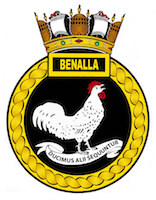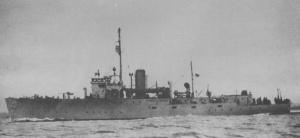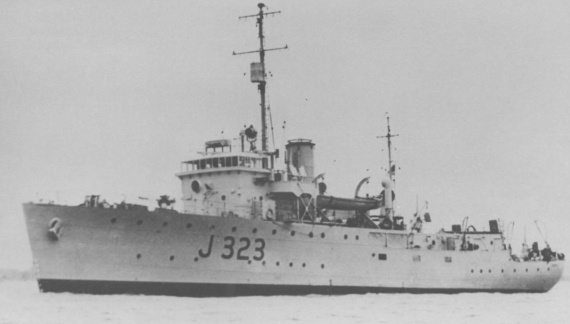HMAS Benalla (I)
| Class |
Bathurst Class |
|---|---|
| Type |
Australian Minesweeper |
| Role |
|
| Pennant |
J323 |
| Motto |
We Lead Others Follow |
| Builder |
Melbourne Harbour Trust, Williamstown |
| Laid Down |
24 March 1942 |
| Launched |
19 December 1942 |
| Launched by |
Mrs Drakeford, wife of the Minister for Air and Minister for Civil Aviation |
| Commissioned |
27 April 1943 |
| Decommissioned |
28 January 1946 |
| Fate |
Sold for scrap on 20 February 1958 |
| Dimensions & Displacement | |
| Displacement |
|
| Length | 56.69 metres |
| Beam | 9.45 metres |
| Draught | 2.59 metres |
| Performance | |
| Speed | 15 knots |
| Complement | |
| Crew | 107 (larger than standard war complement due to survey duties) |
| Propulsion | |
| Machinery | Triple expansion engine, 2 shafts, 2,000 hp |
| Horsepower | 2000 |
| Armament | |
| Guns |
|
| Other Armament | Depth charge chutes and throwers |
| Radars | Types 271 & 291 radar fitted in 1943 |
| Awards | |
| Battle Honours | NEW GUINEA 1942-44 |

HMAS Benalla (I) was one of sixty Australian Minesweepers (commonly known as corvettes) built during World War II in Australian shipyards as part of the Commonwealth Government’s wartime shipbuilding programme. Twenty were built on Admiralty order but manned and commissioned by the Royal Australian Navy. Thirty six (including Benalla (I)) were built for the Royal Australian Navy and four for the Royal Indian Navy.
Although nominally a minesweeper, Benalla (I) was fitted during construction for survey duties and did not carry minesweeping gear. ‘X’ Deck was extended to accommodate a large chart room. Occasionally if her programme permitted Benalla (I) combined convoy escort duty with passage to another operating area.
Benalla (I) commissioned at Melbourne on 27 April 1943 under the command of Acting Lieutenant Commander Leslie N Morison RANR(S).
On 19 May 1943 the ship departed Melbourne for Sydney, where she arrived on 22 May. After completion of trials Benalla (I) was assigned to duty in northern waters. She sailed from Sydney for Brisbane, on 2 June 1943, with an ammunition lighter in tow and arrived at Brisbane on 6 June. On 15 June she sailed for Townsville, arriving on 18 June. En route to New Guinea waters to take up survey duties Benalla (I) was one of the escorts for a convoy of six ships (three for Milne Bay and three for Port Moresby), which departed Townsville on 20 June 1943. Benalla (I)'s sister ship HMAS Katoomba (I) was the second escort. When the convoy split Benalla (I) and Katoomba (I) escorted the Milne Bay and Port Moresby sections respectively. Another sister ship, HMAS Bunbury (I), joined the convoy from Cairns and accompanied Benalla (I) to Milne Bay.
On 30 June 1943 Benalla (I) and her sister ship HMAS Shepparton (I) were units of the naval force supporting the landing by United States troops on Kiriwina Island. Landings on that island and Woodlark Island, both in the Trobriand Group, were unopposed, there being no Japanese troops on the islands. Following this operation Benalla (I) was based at Milne Bay for survey duties.
During July-September 1943 a Survey Group comprising Benalla (I), Shepparton (I), HMA Ships Stella and Polaris and other small craft carried out preparatory work for Australian landings at Lae, Salamaua and Finschhafen. Benalla (I) continued her survey work based at Milne Bay until early December. On 9 December 1943 the ship arrived at Sydney to undergo a refit.
Benalla (I) sailed from Sydney on 29 January 1944 and returned to survey duties in New Guinea waters. During March and April 1944 the ship participated in surveys of Seeadler Harbour (in the Admiralty Island Group) following the capture of the islands by United States troops. In August she returned to Brisbane for a refit lasting two months.
On 11 October 1944 Benalla (I) sailed for Hollandia, from where she sailed for the Philippines on 29 October as part of the escort for 20 United States liberty ships.
Arriving at Leyte Gulf on 4 November 1944 Benalla joined the frigate HMAS Gascoyne (I) for survey duty in San Pedro Bay before returning to New Guinea waters in December where she continued survey work. Christmas Day 1944 was spent at Nuakata Island.
Benalla (I) arrived at Darwin on 6 January 1945 to take up duty with a Survey Group on the Australian north west coast. This work occupied her for four months and on 3 May she sailed from Darwin for Fremantle, where she remained until July. On 20 July Benalla (I) arrived at Darwin to resume survey duty.
Benalla (I) sailed from Darwin on 7 September 1945 as a unit of the Australian/Dutch force ordered to Koepang for the ceremony of surrender of all Japanese forces in Timor. The ships arrived at Koepang on 11 September and at noon that day the Japanese commander signed the instrument of surrender aboard the sloop HMAS Moresby (I).
After returning from Timor, Benalla (I) resumed survey duty in the north western area. On 2 November 1945 she departed Darwin and proceeded to Fremantle. She paid off into reserve at Fremantle on 28 January 1946.
Benalla (I) remained at Fremantle until 25 March 1955, when the tug HMAS Sprightly sailed for Melbourne with Benalla (I) in tow. The ships arrived at Melbourne on 4 April and Benalla (I) remained in reserve but was later transferred to Geelong. While still remaining in reserve the ship was towed from Geelong to Sydney by Sprightly, departing Geelong on 21 January 1956 and arriving at Sydney on 25 January.
On 20 February 1958 Benalla (I) was sold for scrap to Mitsubishi Shoji Kaisha Ltd of Tokyo. The Japanese salvage vessel Tokushima Maru sailed from Sydney on 25 April 1958 with Benalla (I) in tow and in due course she was broken up for scrap in Japan.
Note: This video is hosted on YouTube. Department of Defence users will not be able to view this video on the Defence Protected Network.
This cine film has been placed online as part of the Sea Power Centre - Australia’s ongoing archival digitisation program.
Further reading
- The Corvettes: Forgotten Ships of the Royal Australian Navy, by Iris Nesdale Published by the author, October, 1982.
- Corvettes - Little Ships for Big Men, by Frank B. Walker Published by Kingfisher Press, NSW, 1996.
- The Australian Centenary History of Defence Volume III, The Royal Australian Navy, edited by David Stevens, Oxford University Press, South Melbourne, Victoria, Australia, 2001.












